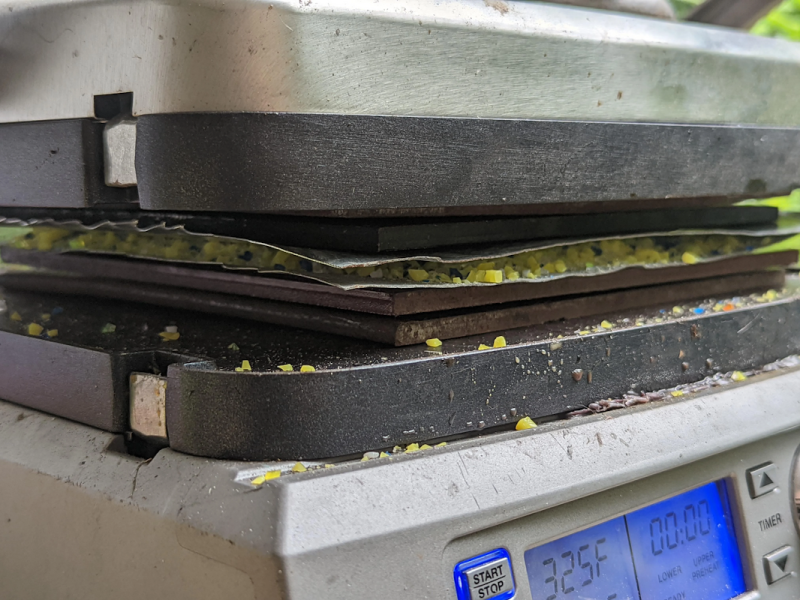Living and working in a remote rain forest may sound idyllic to those currently stuck in bland suburbia, and to be sure it does have plenty of perks. One of the downsides, though, is getting new materials and equipment to that remote location. For that reason, [Digital Naturalism Laboratories], also known as [Dinalab], has to reuse or recycle as much as they can, including their scraps of acrylic leftover from their laser cutter.
The process might seem straightforward, but getting it to actually work and not burn the acrylic took more than a few tries. Acrylic isn’t as thermoplastic as other plastics so it is much harder to work with, and it took some refining of the process. But once the details were ironed out, essentially the acrylic scraps are gently heated between two steel plates (they use a sandwich press) and then squeezed with a jack until they stick back together in one cohesive sheet. The key to this process is to heat it and press it for a long time, typically a half hour or more.
With this process finally sorted, [Dinalab] can make much more use of their available resources thanks to recycling a material that most of us would end up tossing out. It also helps to keep waste out of the landfill that would otherwise exist in the environment indefinitely. And, if this seems familiar to you, it’s because this same lab has already perfected methods to recycle other types of plastic as well.


















Aww thanks for sharing hackaday!
Also gonna plug offcut studio who gives workshops on this for people who want to learn how to do this in a less janky way than us :)
https://instagram.com/offcutstudio?igshid=YmMyMTA2M2Y=
I think my biggest question is why they have to use plastics in the first place to make trinkets in a remote forest location? Why not make something sustainable that someone visiting might actually want to buy as a memory of the place?
It turns into one of those Aesop’s “Miller and his son trying to sell their ass” farces..
A: “Yah, chop down the trees instead”
B: “No chop down trees”
C: “Make indiginous sovenirs”
D: “Possessing indiginous sovenirs is cultural appropriation”
…
My best guess is that if the place in question is described as a prototyping studio, they’re probably more interesting in having useful equipment running, like a laser cutter, rather than figuring what combination of macaw feathers and woody fruits a tourist is more likely to buy.
Yep.
We build scientific instruments for biologists here. Plus we take th scraps from the town like polypropylene and HDPE and shred and use those to prototype too.
Any extra stuff we cut into little earrings or keychains to fundraise for the animal rescue
What’s the melting point of acrylic? I see online 320F(160C). Would the process be better served by getting close to the melting point and compressing the semi-liquid between 2 hot plates?
By the way, I like the effect of multi-colored acrylic used for decorative pieces. What’s the cut time for that thickness on the laser cutter?
That’s exactly what we are doing, we heat it to like 325 and then squish between hot plates. It’s not a liquid though, that’s the big difference between acrylic and other thermoplastics, it just gets kinda rubbery. That’s why you need a lot of pressure :)
Gotcha. I couldn’t find any information on liquification of acrylic. figured it didn’t allow for that. Are the jack presses heated at any point? Wonder if you can speed up the time required if the plates for pressing were at or near the 325 mark.
The acrylic cuts quite easily on most laser cutters. A little keychain would be like a minute